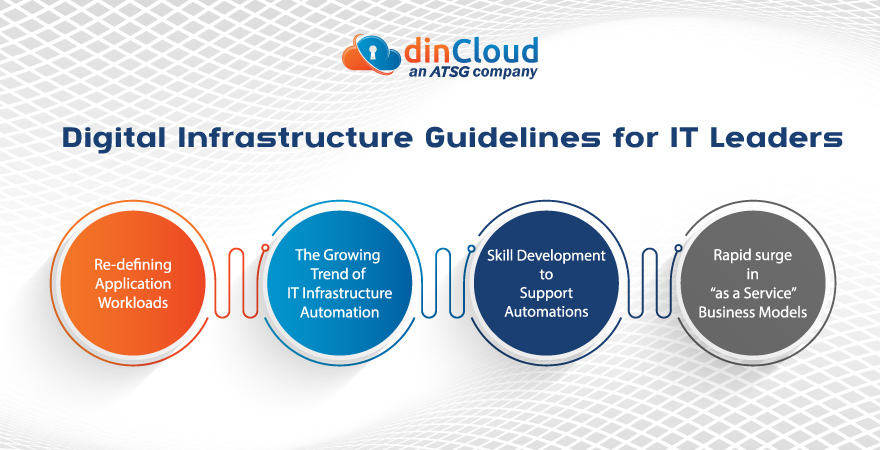Technology is everywhere, and it has revolutionized and reshaped the modern workplace. So much so, the traditional ways to manage networks, compute, and storage, are no longer sufficient. In order to keep up, agile and flexible digital infrastructures are required that can lay a solid foundation for enterprise IT operations.
Remember, the ability of businesses to transform and adapt according to changing environments is of utmost importance. Just because something has worked out in the past, does not mean it will continue to do so in the future as well. This mentality is dangerous and can put you behind the innovation curve, and weaken your position among competitors.
This is the reason why Infrastructure and Operations (I&O) leaders have to keep pace with the latest technologies to fulfill enterprise goals, and to attain as well as maintain a competitive edge. The last decade has particularly seen a paradigm shift in enterprises’ digital infrastructures.

I&O leaders no longer have to worry about the hassle of physically deploying hardware or compute-intensive systems for their enterprises. Today, it is all about delivering services that fulfill enterprises’ requirements in an efficient and cost-effective manner.
Gartner is a leading management consulting company, and its insights and guidance hold a significant place among enterprises. Gartner has pointed out the following trends and predictions, that can help enterprises navigate the path toward flexible and cost-effective digital infrastructures.
Related Posts
- The Critical Role of Digital Infrastructure in Today’s Business Landscape
- How to Navigate Digital Transformation?
- How to Leverage the Cloud to Optimize Digitization?
- Key Tech Trends Shaping Digital Transformation in the Pharma Industry
1. Re-defining Application Workloads
At present, the ratio of cloud-native applications is relatively slim, but this number is consistently increasing at a fast pace. According to Gartner’s report, workloads will be divided in the following ways, by the year 2025.
- Approximately one-third of workloads will run in the Cloud.
- The other one-third will migrate to cloud-based platforms soon, as higher complexities have stretched the implementation timelines.
- 35% of the remaining workloads will stay on-premise, due to security, regulatory, and compliance concerns.
I&O leaders have a huge role to play here. They should work towards the modernization of legacy applications. This way, a large number of applications can be migrated or shifted to the Cloud. This will standardize and optimize their infrastructure, reducing any complexities and additional costs.
2. The Growing Trend of IT Infrastructure Automation
Usually, one of the top concerns of enterprises is to achieve cost optimization. In Gartner’s 2021 I&O Leaders Survey, it was found that I&O leaders considered infrastructure automation as the key enabler for significantly reducing costs. Not just that, Structured Infrastructure Automation also delivers efficient workflows and significantly reduces the chances for human errors.
Due to this, 70% of organizations are predicted to adopt automation within their IT infrastructures, by the year 2025. However, the problem is that enterprises usually struggle to adopt seamless and effective infrastructure automation. They can start off their journey by following these steps.
- Develop an action plan and devise effective strategies to undergo this process.
- View automation as an ongoing process, and keep on coordinating with the required entities for maximum output.
- In order to ensure scalability and consistency, it is important that you develop a separate team for your automation journey.
3. Skill Development to Support Automation
In order to make automation initiatives successful, it is vital that enterprises go beyond the deployment of just the tools and technologies. They should look for ways to develop a mix of skills, especially the ones required to support automation initiatives across their IT environments.
In 2021, it was reported that less than 10% of the enterprises had developed the required skills to undertake infrastructure automation successfully. The report by Gartner paints an optimistic picture and predicts that this number will reach up to 50%, by the year 2025.
It is pivotal to clearly define the roles and responsibilities of designated employees, for structured infrastructure automation. This way, the automation technology will not end up becoming a “black box”, that no one completely understands.
4. Rapid surge in “as a Service” Business Models
According to another prediction by Gartner, nearly 40% of on-premise storage and compute resources will shift to an as-a-service business model, by 2025. There are multiple reasons for this shift, some of which are listed below.
- “As a service” business models in general, and Cloud Computing solutions in particular, ensure agility, slash unintentional costs, and remove the chances of vendor lock-ins.
- The Pay-as-you-go pricing model of Cloud Computing solutions is extremely convenient. They not only reduce overall costs and operating expenses but also reduce resource wastage.
- A large number of system providers are also starting to make a shift from their capital-intensive systems towards “as a service” offerings, due to their inherent flexibility and scalability.
Conclusion
The shift to digital infrastructure might initially seem like an overwhelming task, but it will definitely be well worth it. Market surveys and research make it evident that a vast majority of forward-thinking Infrastructure and Operation (I&O) leaders are well on their way to shifting toward digital infrastructures.
For this process, they must realize the importance of automation, modernization, and as-a-service business models. In addition, if they manage to develop new skills necessary to make automation work, success is inevitable.
Contact dinCloud, an ATSG company, for flexible, secure, and agile Cloud Computing solutions, that come with transparent and flat-rate pricing models for your enterprise.


